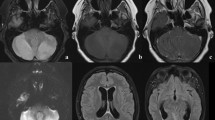Abstract
Pseudotumor cerebri (PTC) presents with varied spectrum of manifestations, association with diverse pathological conditions and variable outcome. A preliminary observation on children presenting with PTC is being presented because of certain peculiarities, not observed earlier, like occurring in clusters during particular season, all were infants having close relationship with viral illness and all had extremely benign outcome. Children presenting with raised ICP were hospitalised and evaluated. The relevant investigations carried out included lumbar puncture, cranial ultrasonography, CT Scan and culture studies. Fifteen children, all in infancy with male-female ratio of 2 : 3 presented in clusters of 11 (73.3%) cases during late summer and early fall presented with bulging fontanelle15, vomiting 11, fever 12, respiratory infection 5, diarrhea 5, lateral deviation of eye balls 4 and skin rashes 5 cases. Contact with viral illness in the family was found in 10 cases. Lumbar puncture showed high opening high CSF pressure in all. Results of this study suggest peculiar and perhaps different form of PTC seen recently which affected only the infants. These were closely related to viral illness and had benign outcome.
Similar content being viewed by others
References
Wald SL. Benign intracranial hypertension (Pseudotumor cerebri) In : Walrer G. Bradley, Robert B. Daroff, Gerald M. Fenschel, David Marsden C, eds.Neurology in clinical practice. Butterworth Heinmann, 1989 : 1230–1233.
Fishman RA. The pathophysiology of pseudotumor cerebri: An unsolved puzzle (editorial).Arch Neurol 1984;41 : 257.
Duncan FJ, Corbett JJ, Wall M. The incidence of pseudotumor cerebri.Arch Neurol 1988;45: 1358–1362.
Chutorian AM, Gold AP, Braun CW. Benign intracranial hypertension and Bell’s pasly.N Eng J Med 1977; 296: 1214–1219.
Sorchs LO, Syndstorm B. Intracranial, hypertension in a child during treatment with naidixic acid.Br M J 1967; 2: 744–745.
Corbett JJ. Problems in the diagnosis and treatment of pseudotumor cerebri.Can J Neurol Sci 1983; 10: 221–226.
Aulnorn E. Ophthalmological features of pseudotumor cerebri: Report on 18 cases.Doc ophthalmo 1984; 58 : 25–33.
Corbett JJ, Savino PJ, Thompson HSet al. Visual loss in pseudotumor cerebri: Follow-up of 57 patients from five to forty-one years and a profile of 14 patients with permanent severe visual loss.Arch Neurol 1982; 39 : 461–474.
Janny P, Chazal J, Colnet Get al. Benign intracranial hypertension and disorders of CSF absorption.Surg Neurol 1981; 15: 168–174.
Donaldson JO. Pathogenesis of pseudotumor cerebri syndrome.Neurology Minneapolis 1961; 31: 877–883.
Sklar FH, Beyer CW Jr, Ramnathan Met al. Cerebrospinal fluid dynamics in patients with pseudotumor cerebri.Neuro-surgery 1979; 5: 208–216.
Author information
Authors and Affiliations
Rights and permissions
About this article
Cite this article
Tamer, S.K., Tamer, U. & Warey, P. Infantile pseudotumor cerebri related to viral illness. Indian J Pediatr 63, 645–649 (1996). https://doi.org/10.1007/BF02730810
Issue Date:
DOI: https://doi.org/10.1007/BF02730810




